
5 Tips To Help You Achieve Great UX Design Flow To Try Now
A website that provides a great user experience (UX) connects better with users and promotes products and services effectively to customers. With great UX, a website can retain customers and turn them into loyal brand advocates.
It takes an experienced Las Vegas UX design agency to build successful, converting websites. Let us look at the top five tips to achieve great UX:
- Understanding users.
- Creating a clear information architecture.
- Optimizing interaction design.
- Focusing on visual design.
- Testing and iteration.
Build UX-focused websites with these great tips. Let’s go!
To learn how Digital Authority Partners can create a standout website for you, watch this video!
1. Understand Your Users
To create websites with impressive UX design, experts begin by thoroughly understanding the target users and their needs. This knowledge guides design decisions and helps create a flow that aligns with user expectations. Consider these best tips to understand users and make a great UX design:
- Use various research methods, such as surveys, interviews, and user testing, to gather insights about the target audience. Explore behaviors, preferences, goals, and pain points related to the product, service, or website that you are designing.
- Create user personas based on research findings to visualize and understand the users' characteristics, motivations, and needs.
- Analyze the UX design of similar products or competitors in the industry to get valuable insights into industry standards and differentiate your design by addressing gaps in existing solutions.
- Monitor user analytics data, such as website traffic, user behavior patterns, and conversion rates, to uncover valuable insights about user preferences, popular features, and areas that need improvement.
- Create empathy maps to better understand users' thoughts, emotions, and behaviors throughout their journey with the product, service, or website.
2. Create a Clear Information Architecture

Creating a clear information architecture involves organizing and structuring content in a way that makes sense to users. Some ways to establish this include an intuitive navigation system, hierarchy, and labeling conventions so that users can easily find what they need. These tips improve information architecture and promote great UX design:
- Define the primary goals and tasks of users. Prioritize important content and make it easily accessible, creating a smooth flow from entry points to desired outcomes.
- Establish a logical hierarchy using headings, subheadings, and categories to structure content and guide users through the information flow.
- Use a clear and consistent navigation system, such as a top menu, sidebar, or breadcrumb navigation, to give users a sense of orientation.
- Implement a search feature to allow users to quickly find specific information or products. Ensure that the search functionality is prominently placed and easily accessible.
- Test the information architecture with real users to identify usability issues or confusion. Conduct card sorting exercises or tree testing to validate and refine the structure.
3. Optimize Interaction Design
Interaction design is how users interact with a product, service, or website. Several strategies promote excellent interaction design, such as using familiar UI elements, including buttons, menus, and forms, and visual cues, animations, and transitions to provide feedback and guide users through the flow. To optimize interaction design, expert designers use these strategies:
- Understand user mental models, or how they perceive and expect interactions to work based on their prior experiences. Use familiar user interaction patterns and behaviors to create a sense of familiarity.
- Provide immediate feedback when they interact with the website or product through button clicks, form submissions, or menu selections. Use loading animations, progress indicators, or success messages to assure users.
- Simplify interactions wherever possible by removing unnecessary steps or interactions, keeping forms concise, and avoid requesting excessive information.
- Use consistent and predictable UI elements and interaction patterns such as buttons, icons, and menus throughout the website.
- Incorporate micro-interactions or subtle, purposeful animations or responses that provide feedback and enhance the user experience.
- Conduct user testing to uncover usability issues and gather valuable feedback. Iterate and refine the design based on the insights gained through user testing.
4. Focus on Visual Design

Visual design has a significant role in UX, as it impacts the overall look and feel of the website. Consistency is vital in graphic design as it develops a cohesive and familiar user experience.
Establishing a consistent visual language throughout the website, including color schemes, typography, iconography, and spacing, can help users navigate and understand the website interface. Here are more tips:
- Prioritize readability and accessibility using legible fonts and appropriate font sizes for different content types.
- Design with accessibility guidelines, considering color blindness and screen reader compatibility.
- Use visual hierarchy to guide users’ attention and communicate the relative importance of different elements on the screen. Use size, color, and positioning to highlight important information and emphasize critical actions and content.
- Incorporate white or negative space to enhance visual clarity and reduce cognitive overload.
- Integrate visual cues within the design. Utilize button styling, hover effects, and interactive animations to show the clickable or interactive nature of UI elements.
5. Test and Iterate
Through user testing and iterative design, experts refine the UX design flow. They conduct usability testing sessions to observe how users interact with the website and gather insights for improvement. To test and iterate for great UX design, remember these best practices:
- Set up usability testing sessions with real users to observe how they interact with the website. Define specific tasks to complete and gather feedback on their experiences.
- Gather qualitative feedback to get valuable insights into user expectations, frustrations, and areas for improvement.
- Analyze quantitative data collected through user analytics. Look at metrics such as click-through rates, conversion rates, bounce rates, and time on task to identify UX design challenges or areas that need improvement.
- Identify common pain points, usability issues, or areas users struggled with during testing and analysis.
- Conduct A/B testing to test variations of specific design elements, layouts, or functionalities and measure the effect on user behavior.
- Seek feedback from stakeholders, such as product managers, developers, and other designers, to gain different perspectives on the design.
- Collaborate with UX experts or conduct design reviews to gather additional feedback and insights to improve UX design.
- Iterate continuously by regularly revisiting and refining the design based on user feedback, emerging trends, and evolving user needs. This ensures that the website remains user-centered and aligned with current best practices.
Summing Up
Achieving a great UX design flow is an ongoing process. Continuously gather user feedback, analyze data, and stay updated with current design trends to refine and improve the UX design flow over time. Remember the best tips outlined above when designing your website for user satisfaction.
Partner with the best Las Vegas UX design agency for websites that provide excellent UX. Call Digital Authority Partners (DAP) for the latest and best in UX design.
Want To Meet Our Expert Team?
Book a meeting directly here




